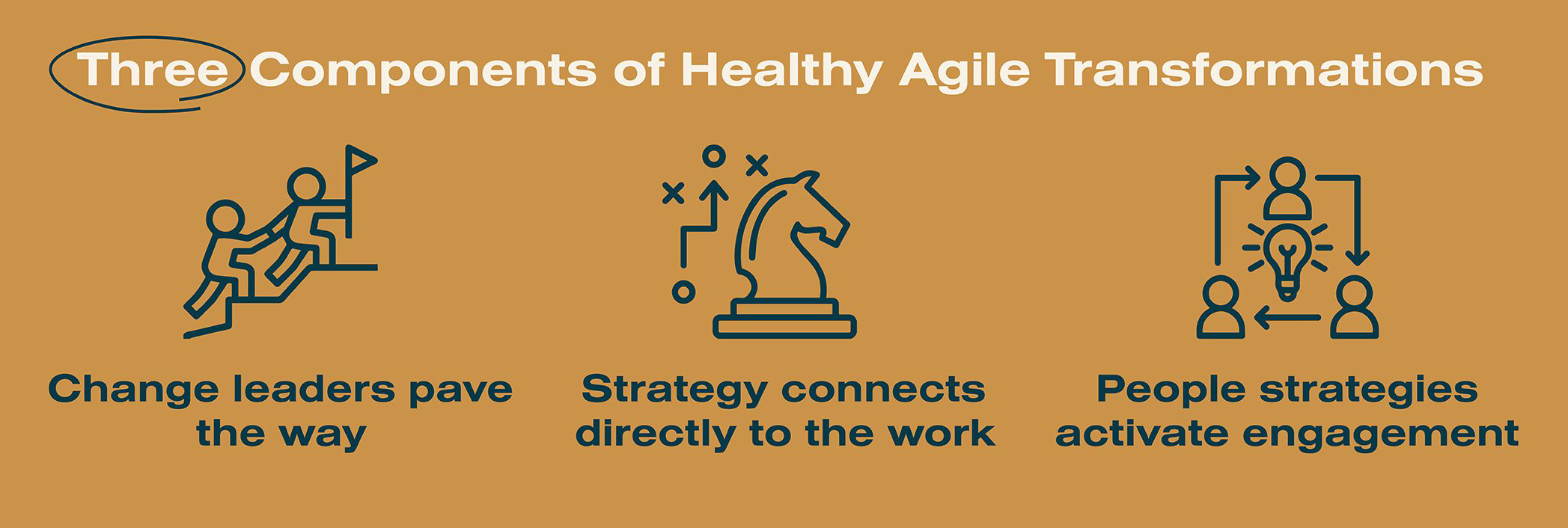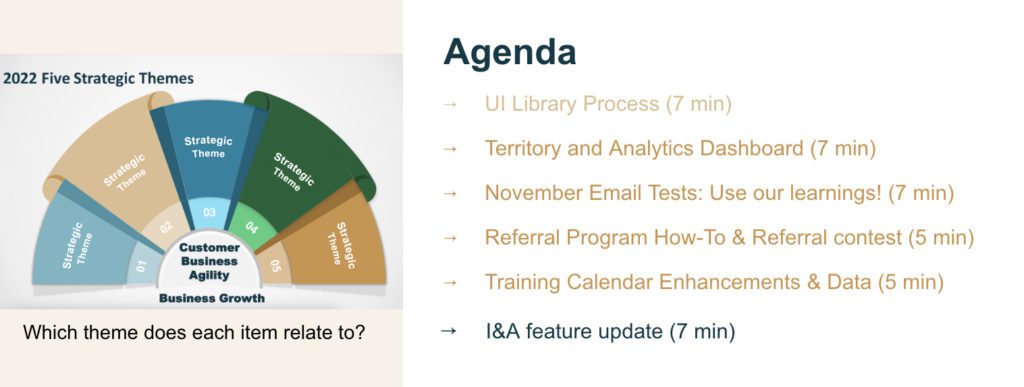
Improving your health is important so you can live a longer life. The same goes for your Agile transformation.
Certain habits improve your transformation’s health. Like eating healthy and working out do for our bodies.
I’ve seen these habits improve and sustain Agile transformations in many organizations:
- Change leaders pave the way
- Strategy connects directly to the work
- People strategies activate engagement
Each of these habits signals your organization embraces real change. And embracing change is the foundation of a sustainable Agile transformation.

Change Leaders Pave the Way
Leadership is the most important part of a healthy Agile transformation. I’d go as far as saying leaders can make or break transformation efforts.
So leadership teams must lead the change for it to stick. They do this by leading by example at all levels of the organization (from the portfolio to Agile teams).
Change leaders also follow SAFe® Lean-Agile Principles and Core Values when making decisions.
Principles and values guide decisions
Leaders should embrace and demonstrate the principles and values in their leadership roles. And consult them when making a change to one of their transformation strategies.
Easterseals demonstrates one way to apply this thinking in this customer story. The company applied SAFe starting with Lean-Agile leadership. They placed change leaders in key roles. And then added the principles and structures to guide their decisions.
Some organizations disregard the principles and values to tailor SAFe. They make this modification to fit SAFe into their culture. But this creates an anti-pattern.
These modifications may include:
- Changing the names of the roles identified in the Framework
- Picking and choosing which ceremonies to hold
- Training leaders on SAFe without proper leadership coaching and guidance
SAFe is not a prescriptive framework. Yet it’s important to maintain its foundational principles and values. This ensures a healthy Agile transformation.
Read more about how to apply the SAFe Core Values in a work setting here.
Operational excellence objectives facilitate improvements
Change leaders extend their reach through Lean-Agile Communities of Excellence (LACE). LACEs should share transformation learnings across portfolios. This aligns each portfolio to Lean-Agile practices and leadership. It also helps to create a Continuous Learning Culture.
Transformation leaders in the LACE should also spearhead improvement initiatives within the organization. Also, they should focus on cross-training initiatives. This solves bottlenecks and other flow issues.
Leadership sponsorship extends beyond sustaining to accelerating change
In a healthy Agile transformation, leadership doesn’t stop at sponsoring the change. They go as far as participating in and accelerating the change.
When this does not happen, the following pattern can occur.
A Fortune 100 large enterprise pivoted from Waterfall to Agile. (Notice Lean was not even part of the conversation).
Leadership did not choose the method for this transformation. Instead, they pushed this decision to the leaders in each business unit.
You can only imagine what happened. Some business leaders chose SAFe. Others tried a hybrid approach and pulled practices from several Agile frameworks. Others decided to ‘baby step’ it and start with small teams. None of the teams in this ‘small team’ example took into account all the dependencies on the other teams.
Six months in, one leader asked: “Where can I get a holistic view of our product delivery and how we are tracking against all our initiatives?”
With so many frameworks and practices in play, there was no easy way to answer this.
Other impacts?
Business units often worked on initiatives with other business units. But they did not have a common cadence. Or alignment on dependencies or ceremonies. It became chaotic to figure out how to execute together to deliver on business requests.
If leadership selected one framework and language, that would have united the organization. And made the transformation smoother.
This example demonstrates why leadership needs to extend beyond sponsorship to participation. It ensures a transformation’s health and, thus, long-lived success.
Strategy Connects Directly to Daily work
Leadership is in place. Now what? Everyone in a healthy Agile transformation engages in their work. To improve employee engagement, show employees how their work makes a difference.
Make this connection through transparency about your strategies. Show how they align with your enterprise’s Vision and Mission.
How do you make this a healthy habit? By sharing updates during all hands or other standing company-wide meetings.
One way Scaled Agile, Inc. shows its employees how they’re impacting enterprise strategy is through color coding. We assign each strategic theme a specific color (on brand, of course). In System Demo, the agenda is color-coded by the corresponding strategic theme.

This transparency is important, especially when the strategy must pivot. It’s important employees understand the following before any work stops or changes:
- Learnings from the pivot
- The reason for the pivot
Be thoughtful about how you communicate this information with your organization. This is work that many spend the majority, if not all, of their time on. It’s important to be sensitive to this.
Porsche shared an example of strategy transparency at the 2021 SAFe Summit. Their executive leadership committed to how they wanted to work. And which KPIs they would drive with their products. Leadership did this on stage in front of the entire digital division. This commitment launched the digital sector into its first ARTs and PI Planning.
This shared strategy gave employees a reason to stay engaged with their work. They knew they were working towards a common goal across the digital department.
Once employees understand company strategy, they can connect it to their daily work. This connection is important for improving engagement too. Engagement is the final piece of maintaining a healthy Agile transformation.
People Strategies Activate Engagement
One indicator of a transformation’s health is its most important asset: people. To keep your transformation healthy, you must keep your people happy. One way to do this is through actively engaging them in their roles.
Generate future-focused learning opportunities with paths for Agile roles
If employees see growth opportunities, they will likely remain at their current company.
See these recently updated articles for career development inspiration:
Each article includes role descriptions by category. These descriptions provide opportunities for growth in each of these Agile roles.

Organizations can create paths and learning opportunities based on these role-specific focus areas.
Refresh engagement strategies to align with the current workforce
When employees were asked, “What’s one thing that keeps you from being engaged?” they responded with the following reasons:
- No autonomy
- Lack of safe space
- No clear career direction
- Lack of vision and inspiration
- Missing feedback
As mentioned in the previous section, engagement creates happier, more motivated employees. Happier and more motivated employees sustain a healthy Agile transformation.
If your engagement strategies need a refresh, try these suggestions:
- Overhaul outdated engagement strategies
- Align intent with your organization’s social purpose
- Facilitate a relational and emotional connection with employees
- Generate future-focused learning opportunities
- Transform your ceremonies into learning socials
- Connect individual contributions to the organizational vision
- Minimize disruptions to allow for flow
- Look for patterns of inattentional blindness
- Meet people where they are
- Co-create a path to re-engage
To learn more about people engagement strategies, watch my talk from the 2022 SAFe Summit. It’s on the SAFe Community Platform: In It to Win It! People Engagement Strategies to Propel your SAFe Transformation. (Tip: Command + F search the talk title or scroll to the Leading the Change section of the page.)
Connect people to the Vision, Mission, and each other
In a remote/hybrid post-COVID environment, it can feel like you’re working on an island. It’s hard to feel connected to the people you no longer share an office space with.
This connection is important for creating a healthy Agile transformation. Connect people to the following to remind them what they’re working for:
- The organization’s Vision
- The organization’s Mission
- Each other
It gives them the drive to work through the uncomfortable parts of transforming.
Ways you can connect people in your organization:
- Schedule volunteer opportunities for teams
- Add standing mystery 1:1s to the company calendar
- Share rotating appreciations for individual team
- Highlight positive customer experiences, interactions, or success milestones
- Champion learning networks
Conclusion
It takes work to maintain your health. Maintaining the health of your transformation is no different. Incorporate these three components into your Agile transformation. It will give you a strong foundation for sustainable change. And prolong your Agile transformation life.
Other resources to incorporate into your transformation routine. You can think of them like supplements if we’re sticking to the health metaphor:
- SAFe Enterprise: This enterprise-level subscription provides SAFe training and resources.
- Transformation in Practice Panel: This webinar zeroes in on change leadership approaches. Available to SAFe Community members only.
- Measure and Grow Assessments: Check your organization’s health with Measure and Grow Assessments. Available to SAFe Community members only.
About Audrey Boydston

Audrey Boydston is a senior consultant at Scaled Agile and an experienced SPCT, Lean-Agile coach, trainer, and facilitator. Her work focuses on continuous learning, building fundamentals, re-orienting around principles, and helping clients—from senior executives to developers—build networks and communities that support their transformations.